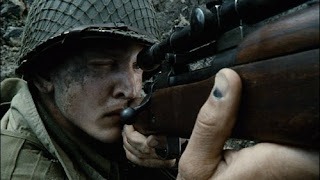
Scene starts with shot of Frank Nitti on the phone in his office. The most well lit object in the shot is his left hand, accentuating the dark deal he is making with..
a dark figure who we see arriving outside of what appears to be a hotel. Not a full scale establishing shot, it is concise, putting the emphasis on the arrival. Notice that the right side doorman is slightly more lit than the left side doorman, the middle being taken up by...
Tom Hanks, as Michael. Here the camera meets Michael in the lobby, eye level, and travels with him through the shot
as he walks to the elevators. Once he turns the corner we go over the shoulder to see the rest of the lobby. The camera stops at the elevators letting Michael get on and turn to the camera, methodical stare as he travels down his own road to perdition, ah ha.
The camera starts out with an overhead and immediately you see how much light the hallway is bathed in as Michael steps out of the elevator, into the light ad possibly towards redemption.
The overhead shot becomes a tall tracking shot that slowly comes back down to his eye level. This is important because despite the fact that Michael went up on the elevator from ground level, we are still looking down on him. The camera comes down because this is Michael's descent into damnation at this point in the film.
In the final few steps before Michael turns the corner, his eyes and most of his figure go black, as our character descends into darkness.
Inside the room the camera stays close to Michael as he scans the room, and we scan with him, until, alas, he finds what he was looking for
and the camera starts to slow dow down and hold back as Michael enters the bathroom.
After the deed is done, Michael walks out of the All White bathroom, his arm slightly catching the bathroom door knob, finally revealing to us what has happened, Michael has shot his step-brother in an attempt to avenge his family.
It is important that only Michael goes into the bathroom and not the camera. It is his journey into darkness, his burden to kill his step-brother, and we must let him go in alone. Also, it looks really cool this way.
As Michael walks out, his back is covered in darkness while he faces and walks towards the light. However he is never fully lit as he leaves the hotel, and the shot ends before he reaches the end of the hallway where he would be bathed in light. By killing his step-brother he damns himself.
This was Conrad Hall's last movie and it was dedicated to him, so subsequently, this shot by shot analysis is also dedicated to the man who framed Cool Hand Luke.


















































